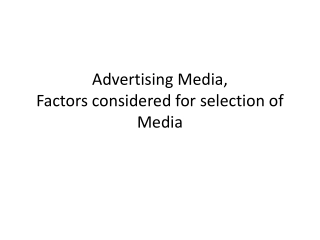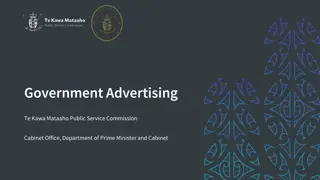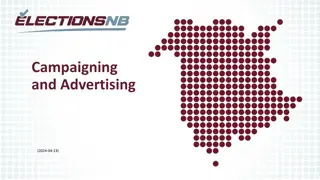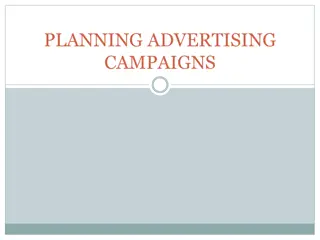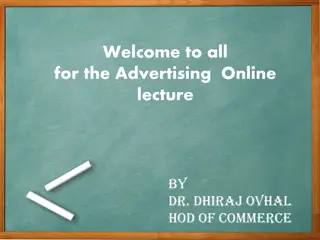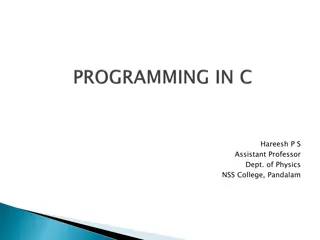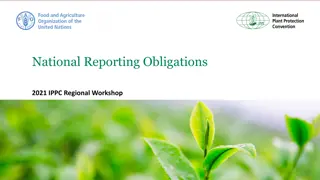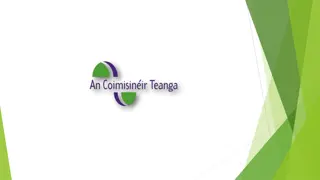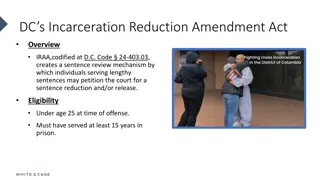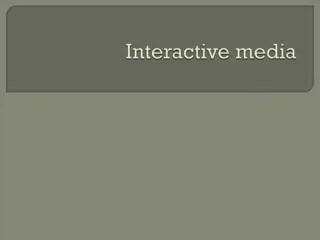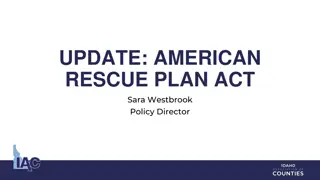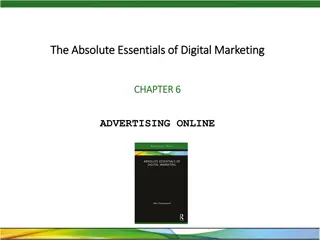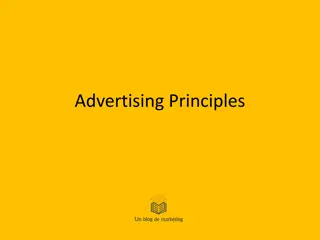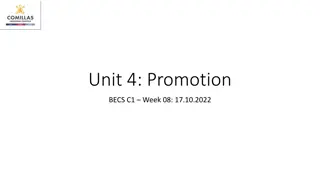Official Languages (Amendment) Act 2021: Advertising Obligations for Public Bodies
The Official Languages (Amendment) Act 2021 strengthens language rights for Irish speakers with provisions for public bodies to use Irish language in advertising. From December 2021, public bodies must ensure a minimum of 20% of advertising is in Irish, with 5% spent on Irish language media. These obligations come into effect on October 10, 2022, with defined criteria for advertising and communication.
Download Presentation

Please find below an Image/Link to download the presentation.
The content on the website is provided AS IS for your information and personal use only. It may not be sold, licensed, or shared on other websites without obtaining consent from the author.If you encounter any issues during the download, it is possible that the publisher has removed the file from their server.
You are allowed to download the files provided on this website for personal or commercial use, subject to the condition that they are used lawfully. All files are the property of their respective owners.
The content on the website is provided AS IS for your information and personal use only. It may not be sold, licensed, or shared on other websites without obtaining consent from the author.
E N D
Presentation Transcript
Acht na dTeangacha Oifigila(Leas), 2021 Alt 10A. F gra ocht ag Comhlachta Poibl Official Languages (Amendment) Act 2021 Section 10A. Advertising by Public Bodies 1
Introductions R n n Domhnaill An Coimisin ir Teanga Oifig an Choimisin ara Teanga S amas Concheanainn Sti rth ir na hOifige Oifig an Choimisin ara Teanga rla de B rca Bainisteoir Gear n Oifig an Choimisin ara Teanga P id Lion ird Bainisteoir Cumars ide Oifig an Choimisin ara Teanga 2
Introduction & Context The Official Languages (Amendment) Act, 2021, enacted in December 2021, strengthens the Official Languages Act 2003. It contains a series of new provisions aimed at strengthening the language rights of Irish speakers. Amongst the provisions of the Official Languages (Amendment) Act 2021, there is a new statutory obligation for public bodies in relation to advertising, general communications and commercial communications which engage with the public. 3
Introduction & Context Section 10A. (Advertising by Public Bodies) of the Act places duties on public bodies in relation to the way they communicate in the State s official languages. The advertising sector is a very important communication medium, and accordingly this new provision is expected to be of considerable importance. The provisions in section 10A. which are defined as follows will come into effect on 10th October 2022. 4
Official Languages (Amendment) Act 2021. Section 10A. Advertising by Public Bodies (1) A public body shall ensure that (a)at least 20 per cent of any advertising placed by the body in any year shall be in the Irish language, and (b) at least 5 per cent of any monies spent on advertising by the body in any year shall be in the Irish language through Irish language media. 5
(2) In this section advertising means (a)any form of commercial communication with the aim or direct or indirect effect of promoting a product or service of the public body concerned, and (b) any form of communication, to the public, in respect of (i) the recruitment of staff, (ii) legislative or policy initiatives, (iii) the purchase or sale of land or assets, (iv) the provision of services, or (v) public consultation; 6
Irish Language Media Irish language media means any media where 50 per cent or more of the content of that media is through the Irish language. 7
Advertising (Section 10A.) - definitions For the purposes of implementing and monitoring section 10A., the following definitions apply. Paid Advertising is any advertising that one pays for. It is always placed with a third party such as a TV channel, radio station, newspaper etc. Owned Advertising is advertising placed by public bodies on their own websites and social media channels etc. Both Paid and Owned advertising are subject to this new provision. 8
Advertising (cont.) Public bodies must ensure: At least 20 per cent of all yearly advertising shall be in the Irish language. At least 5 per cent of yearly advertising spend shall be in the Irish language and published on Irish language media. Irish language media = 50% or more media content through Irish. 9
What falls under these provisions? Advertising by Public Bodies in the following contexts TV/VOD Radio/Audio Press Outdoor Digital Display (Excluding VMS traffic signs) Digital Native Advertising Digital Paid Content An Advertisement (as distinct from content) that runs on owned channels, e.g., a recruitment ad on own website, i.e. section 10A. 2(b)(i) 10
What doesnt fall under these provisions? Content as distinct from advertising on owned media: Digital Content that runs on own media only Press Releases Brochures Newsletters Blogs Paid Search Advertising Shares Posts and reposts (of content as opposed to advertisements) Reviews Influencers 11
Recommended Approach Each of the official languages should be given parity of esteem in all media, for instance, similar copy lengths for TV and radio, similar sizes for print and social. An English language advertisement should not be revoiced in Irish, and an Irish language advertisement should not be revoiced in English. Dubbing or subtitles are not recommended. Advertisements placed with Irish language media will be in Irish only. 12
Recommended Approach (cont.) Irish language media means any media in which 50 per cent or more of the content of those media is through the Irish language (excluding advertisements). The responsibility lies with the public bodies to ensure that 20% of their annual advertising placed by the body is done through the Irish language. The responsibility lies with public bodies to ensure that 5% of their annual general advertising budget is spent on Irish language advertising, on Irish language media. The total of all expenditure, rather than the expenditure of each media channel, may be used for the purposes of the audit. Cost of production will not be considered for the purpose of audit. 13
Measurement OCT has consulted extensively with many Public Bodies as well as sectoral interests, including IAPI (Institute of Advertising Practitioners Ireland) and its media agency members. 20% of any advertising placed (10A. 1 (a)), means 20% of Owned and Paid advertising as defined above. For public bodies that place their advertising through third party media buying agencies, the standard industry measurement systems, e.g. ratings for TV, will apply. 14
Measurement (contd.) Using these guidelines, on slides 16 and 17 - the onus will be on the public body to show that it has complied with the 20% obligation. The 20% obligation does not necessarily have to be applied to each individual advertising campaign. It does have to be 20% in the round at the end of the reporting year. In order to reach the 20% target for campaigns, some bodies may give 1/5 copy rotation instructions to media outlets i.e. instruction to ensure every 5th ad is the Irish language version. This rotation model will be accepted as an indication of compliance. 15
Measurement (cont.) Measurement Measurement Measurement of Measurement of 20% 20% Description Description Media Definition Detail Copy rotation 1 in 5 OR % of Total Circulation (Estimates where no ABC - Audit Bureau Circulation) Circulation refers to number of copies sold on an average day, week or month depending on the frequency of publication. Print/Magazine Advertising % of total average listenership (the number of people who listen to a given radio station). (89k weekly reach Kerry Radio) Copy rotation 1 in 5 OR % of Total Listenership Radio Advertising Copy rotation 1 in 5 OR % of Total Impressions Audio Advertising Digital Audio by % of Total Impressions. OOH - Out of Home/Outdoor Advertising % of Total Sites or 1/5 for digital OOH Total number of poster sites booked for the campaign 16
Measurement Cont. 5% spend on Irish Language Media Media Channel Total Annual Spend Spend on Irish Language Media Total (100%) (5%) 18
Public Body Reporting Public bodies shall be asked to file an electronic compliance return in relation to this requirement no later than 10th March 2024 in respect of 2023 advertising. Compliance will include a record of creative executions in the Irish language. The audit shall be based on data from 2023. If however, a member of the public submits a complaint to An Coimisin ir Teanga regarding the implementation of this statutory obligation, OCT may undertake a compliance inquiry with that public body relating to any complaint made from the 10th October 2022. 19
Irish Language Media All media with at least 50% Irish language editorial content, exclusive of advertising A list will evolve over time and this one is not exhaustive Updates will be provided as they become available E.g. TG4, RnaG, Raidi na Life, Tuairisc.ie, N s.ie, Comhar, Feasta, An Timire, Seachtain 20
FAQ 1. What is the aim of section 10A. (Advertising by Public Bodies)? Section 10A. (Advertising by Public Bodies) is a new provision in the Official Languages (Amendment) additional duties on public bodies in relation to with the public in the State s official languages. Section 10A. sets out specific obligations with Act 2021, which communicating places regard to advertising. 2. When will section 10A. (Advertising by Public Bodies) come into effect? All the provisions regarding advertising by public bodies as prescribed in section 10A. will come into effect on 10th October 2022. All public bodies prescribed under the Act will be obliged to comply with all the provisions of section 10A. from this date.21
FAQ 3. What does the 20% requirement regarding any advertising placed by public bodies mean? 20% of any advertising placed (10A. (1)) means 20% of Owned and Paid as defined above (Sl. 8). For public bodies that place their advertising through third party media buying agencies the standard industry measurement systems, e.g. ratings for TV, will apply. Where bodies do not employ the services of a media buying measurement will be one in five of Owned and agency, the Paid advertising. 4. What does the 5% requirement regarding advertising by public bodies through Irish language media mean in reality? 5% of any monies spent advertising by the public body in any shall be in the Irish language on Irish language media. The measurement will be based on 5% of the total paid advertising budget of the body, in any given year. year 22
FAQ 5. Can production costs be included as part of the annual advertising spend with regard to the 20% and 5% requirements? No, production costs will not be considered for measuring the 5% or 20% requirement. 6. How will compliance with the 20% and 5% requirements be measured by Oifig an Choimisin ara Teanga. Oifig an Choimisin ara Teanga will provide public bodies with a reporting template that will be used to capture key metrics concerning public bodies advertising activities and their compliance with the 5% and 20% requirements. The reporting template will factor in current industry practices regarding advertising and commercial communications to streamline the reporting process as much as possible. 23
FAQ 7. When will monitoring of section 10A. begin? Public bodies will be obliged to comply with all the provisions of section 10A. from 10th October 2022. In addition, Oifig an Choimisin ara Teanga (OCT) will require public bodies to file an electronic compliance return concerning Section 10A. no later than 10 March 2024 regarding advertising for 2023. The return filed by public bodies will form the basis for OCT to measure compliance by public bodies regarding their advertising operations during 2023. 8. Will there be any grace periods for public bodies? No, it is not within the functions or powers of An Coimisin ir Teanga to offer a derogation to any public body from any statutory obligation in the legislation. 24
FAQ 9. What happens if a public body fails to comply with this provision? The following procedures in the primary legislation will be followed to monitor compliance and address any non-compliance by public bodies. investigation of a complaint made by a member of the public or/and monitoring of compliance by Oifig An Choimisin ara Teanga a statutory investigation can be initiated, if required findings/recommendations are made in the statutory investigation report if non-compliance persists, An Coimisin ir Teanga can lay a report detailing this situation of non-compliance by the public body before the Houses of the Oireachtas. 25
FAQ 10. How is Irish Language Media defined? As prescribed in section 10A.(2), Irish language media means any media where 50 per cent or more of the content of those media is through the Irish language. A list of Irish language media will be provided. 11. Who decided on the 5% and 20% requirements in Section 10A.? The Houses of the Oireachtas decided that these provisions should be included in the Official Languages (Amendment) Act 2021. Accordingly, President Michael D Higgins signed the Official Languages (Amendment) Bill 2019 into law on 22 December 2021. 26
FAQ 12. With regard to the 20% requirement, does this extend to advertising carried out through social media channels? Yes, the 20% requirement will extend to social/digital media platforms. As with current industry practices it is understood that social media channels/platforms can be used for both paid and owned advertising placed by the public body. 13.Can the 20% be a combination of Paid and Owned advertising? Yes, provided that the public body can show the data on the percentage (%) or impressions reached on their owned media. 14. With regard to the 5% annual expenditure through Irish language media requirement, does this extend to social media channels? Presently, the 5% expenditure through Irish language media requirement will not extend to social media as Irish-medium versions of these platforms do not exist at this time. 27
FAQ 15. Is paid and owned media subject to the 20% requirement? Yes, both paid advertisements placed with a third party and advertisements placed on owned media, e.g. company websites, social/digital media platforms etc., are subject to the 20% provision for the purposes of both: any form of commercial communication (10A. (2)(a)) AND any form of communication to the public (10A. (2) (b)). The provision regarding any form of communication to the public relates to advertising in the following domains: (i) the recruitment of staff (ii) legislative or policy initiatives (iii) the purchase or sale of land or assets (iv) the provision of services or (v) public consultation 28
FAQ 16. Is paid and owned media subject to the 5% requirement? Yes, as the 5% requirement relates to expenditure ( any monies spent 10A. (1) (b)) only paid advertising will come under the aegis of the provision. 17. Do native posts on social media fall within the confines of section 10A.? No, unless the post includes an advertisement. 29
FAQ 18. Are boosted posts on social media considered paid advertising? Yes, if the boost forms part of any spend on advertising. 19. Does informational video content produced for or generated by public bodies and embedded on owned media (website or twitter platform) fall subject to section10A.? No 20. Can Irish language advertising be broadcast on English- medium media/platforms to satisfy the 20% requirement? Yes. 30
FAQ 21. Does the 20% requirement relate to overall organisation advertising or 20% of each advertisement? The 20% requirement relates to a public body s overall advertising output in a particular year. Having a portion of a particular advertisement, e.g., 20% in Irish, and the remaining 80% in English, is not acceptable. Each of the official languages should be given parity, e.g., similar copy lengths for TV and radio, similar sizes for print and social media. Whether an advertisement is in English or Irish, the language used should be of a high standard. 31
FAQ 22. Will outdoor advertising campaigns run on behalf of public bodies come under the scope of Section 10A.? Yes. 23. Can Irish language advertisements be broadcast consecutively with English language advertisements on English-medium media/platforms to satisfy the 20% requirement. Yes. 24. Will public bodies be permitted under section 10A. to use local or regional media to meet the 20% requirement if it is the case that it doesn t use national TV or Radio for advertising? 32 Yes.
FAQ 25. Will public procurement/OGP notices fall within the scope of section 10A? Yes, when the notice is placed as an advertisement. 26. Will public procurement on e-tenders be considered as advertising, specifically mini-competitions under frameworks not open to public view? No. 33
FAQ 27. Do public notices, e.g. planning notices, road traffic notices fall within the scope of section 10A? Planning notices and road traffic notices issued by a public body will fall within the scope of subsection 10A.2(b): any form of communication, to the public, in respect of (i) the recruitment of staff, (ii) legislative or policy initiatives, (iii) the purchase or sale of land or assets, (iv) the provision of services, or (v) public consultation; 34
FAQ 28. Does bilingual advertising meet an organisation's 20% obligation? Yes, but the following caveat is important. Two separate advertisements, one in Irish and one in English, conveying the same information, are acceptable. Having a portion of a one advertisement, e.g., 20% in Irish, and the remaining 80% in English, is not acceptable. Each of the official languages should be given parity, e.g., similar copy lengths for TV and radio, similar sizes for print and social media. Whether an advertisement is in English or Irish, the language used should be of a high standard. 35
FAQ 29. Are public information campaigns considered as advertising under Section 10A.? Yes, and particular consideration should be given to subsection 10A.2(b) in this regard: any form of communication, to the public, in respect of (i) the recruitment of staff, (ii) legislative or policy initiatives, (iii) the purchase or sale of land or assets, (iv) the provision of services, or (v) public consultation 36
FAQ 30. Would a newsletter fall under advertising? No. However an advertisement placed on a newsletter is subject to the provisions of section 10A., if it is used by a public body for the purpose of the definitions set out in sections 10A.(2)(a) and 10A.(2)(b) 37
FAQ 31. Does the act cover marketing communications such as informational / promotional emails, advertorials, new service or product announcements? Yes, section 10A. covers each of these forms of communications. 32. Are there any contexts in which ad spend internationally falls within the confines of section 10A.? Once a public body is prescribed under the Official Language Acts it must adhere to the provision. Section 10A. doesn t distinguish between national and international spend. 38
FAQ 33. What are the implications for longer or multi-annual contracts that public bodies have already in place with media buying agencies where it may prove impossible to meet the 20% or 5% requirements? It is required that public bodies comply with the new provisions in section 10A. and that all efforts in doing so are documented. As previously stated, An Coimisin ir Teanga does not have the functions or powers to offer a derogation to any public body from any statutory obligation in this legislation. 39
FAQ 34. If vacancies are advertised in Irish, does this mean that public bodies need to facilitate the recruitment-application process in Irish, run case studies in Irish, and conduct the interviews in Irish? No, unless a public body has a commitment in its language scheme, which specifies that it will run its recruitment operations accordingly through the medium of Irish. Language schemes are confirmed by the Minister for Tourism, Culture, Arts, Gaeltacht, Sport and Media. Language schemes will be replaced by language standards as prescribed in sections 19a 19d of the Official Languages (Amendment) Act 2021. However, when implemented, language standards may place an obligation on public bodies or categories of public bodies to undertake some recruitment campaigns through the medium of Irish. 40
FAQ 35. Will supporting documentation relating to advertisements but that will not include part of the advertisement seen by the public need to be also translated too? No. However, some exceptions may arise, as pointed out in FAQ 34. For example, if a public body had committed to it in its language scheme, it would run some of its recruitment campaigns through the medium of Irish. In this case, candidates could have access to supporting documentation that would not appear in advertisements but would nevertheless come under the scope of the commitment in the language scheme confirmed by the Minister for the public body. 41 (Cont. slide 42)
FAQ 35 contd. Language standards under the new Act will replace language schemes. The current obligations under section 10 of the Official Languages Act 2003, which require public bodies to publish certain documents simultaneously in the official languages, will continue. 42
FAQ 36. The geographic jurisdiction that our public body is responsible for, doesn t include a Gaeltacht region. Is our public body obliged to comply with the 5% and 20% targets? Yes, all public bodies are obliged to comply with the provisions prescribed in section 10A. 37. What is the function of An Coimisin ir Teanga with respect to advising public bodies on Section 10A. Section 21 (e) of the Official Languages Act 2003 prescribes it as a function of An Coimisin ir Teanga: to provide, as he or she considers appropriate, advice or other assistance to public bodies regarding their obligations under this Act. 43
FAQ 38. What are the functions of An Coimisin ir Teanga with respect to ensuring compliance by public bodies with Section 10A.? Section 21 (a), (b) & (c) of the Official Languages Act 2003 prescribes the following functions of An Coimisn ir Teanga: s.21 (a) - to monitor compliance by public bodies with the provisions of this Act s.21 (b) to take all necessary measures within his or her authority to ensure compliance by public bodies with the provisions of this Act s.21 (c) - to carry out investigations, whether on his or her own initiative, on request by the Minister or pursuant to a complaint made to him or her by any person, into any failure by a public body to comply with the provisions of this Act that he or she or, as appropriate, the Minister, considers may have occurred. 44
FAQ FAQ 38. cont. Section 26. (5) prescribes: If, within a reasonable time after a report containing recommendations is submitted to a public body under subsection (2), any recommendations contained in the report have not, in the opinion of the Commissioner, been implemented by that body, the Commissioner may, after considering any responses made to him or her by the public body in respect of those recommendations, make a report thereon to each House of the Oireachtas. 45
Go raibh mle maith agaibh Questions please? eolas@coimisineir.ie An Spid al, Co na Gaillimhe. H91VK23 46
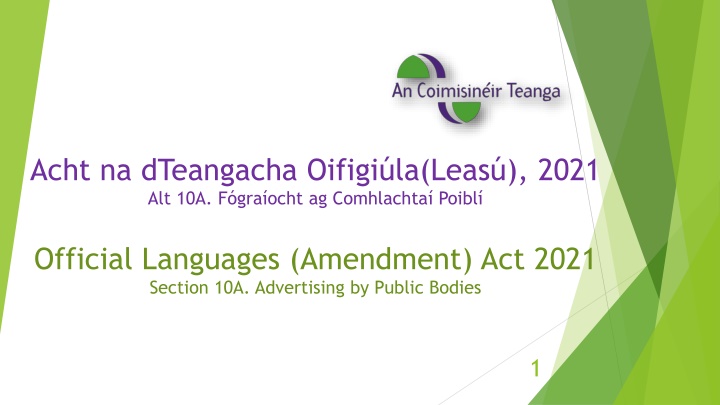


![RE: ELECTORAL MATTERS AMENDMENT BILL [ B42-2023]](/thumb/18837/re-electoral-matters-amendment-bill-b42-2023.jpg)
